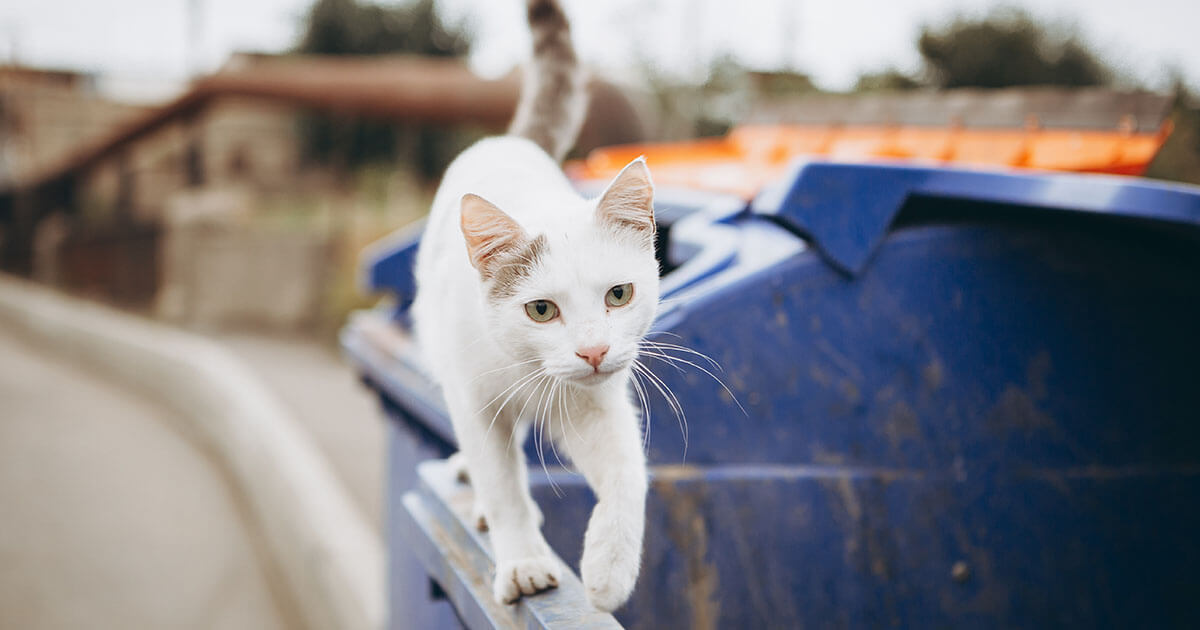Stray cats are typically independent and resourceful animals. They often display wariness around humans and have a strong territorial instinct.
Stray cats, often known as feral cats, possess a distinctive set of characteristics shaped by their experiences of living without direct human support. These felines are usually highly agile, alert, and survive by scavenging or hunting, which hones their instincts.
Their coats may appear less groomed than those of domestic cats due to their rough living conditions. Trust with humans can be a slow process as they rely primarily on self-preservation in unpredictable environments. Understanding these traits is crucial for anyone who might encounter or wish to help stray cats. With patience and care, some may eventually adapt to safer, more stable lives if given the opportunity.
The World Of Stray Cats
The World of Stray Cats opens a window into the lives of mystery wanderers that grace our alleyways and backyards. Stray cats, often born in the wild, exhibit a range of intriguing behaviors as they adapt to survive without an owner. With sharp instincts and quick reflexes, these felines are the epitome of resilience and resourcefulness. Now, let’s delve into the fascinating characteristics and survival mechanisms of these nimble creatures.
Distinctive Traits
Stray cats are known for their distinctive traits that set them apart from their domesticated counterparts:
- Survival Skills: With powerful hind legs and acute senses, strays easily escape danger.
- Independent Spirit: Their solitary nature is key to their adaptability.
- Stealth and Cunning: Silent paws and a sharp mind make them excellent hunters.
Population Dynamics
Population dynamics among stray cats tell a tale of community and struggle:
| Aspect | Detail |
|---|---|
| Group Structure: | In colonies, cats share resources and maintain a hierarchy. |
| Reproduction: | High birth rates can lead to more strays without intervention. |
| Challenges: | Lack of food, disease, and human threats affect populations. |
Understanding these characteristics is vital for communities aiming to support stray cat welfare ethically and effectively.

Credit: www.amazon.com
Survival Skills Of Urban Felines
Urban stray cats possess an array of skills that allow them to navigate the concrete jungle. These survival skills are a testament to their adaptability and resilience. Understanding these behaviors shines a light on the tough lives of these city-dwelling felines.
Scavenging And Hunting
Stray cats are masters at finding food in the urban landscape. Their daily quest includes:
- Exploring trash bins for leftover scraps.
- Catching rodents or birds with stealth and agility.
- Using their keen senses to locate potential meals.
These practices keep stray cats fed and ready for the challenges of the streets.
Territorial Behaviors
Stray cats claim areas which they patrol regularly. Key aspects of their territorial nature involve:
- Marking their territory with scents.
- Guarding their space against intruders with fierce determination.
- Creating safe havens for rest and retreat.
These territorial tactics are crucial for a stray cat’s survival in the urban sprawl.
Social Structure Among Strays
Social Structure Among Strays reveals the complex and fascinating world that feral felines inhabit. Like a puzzle, each cat’s role and relationships contribute to the street’s dynamic ecosystem. Observing these behaviors showcases nature’s unwritten rules at play. Let’s delve into the intricacies of their social hierarchy and interactions.
Hierarchy And Social Bonds
Stray cats often establish a clear pecking order. This hierarchy maintains order and reduces conflicts within the group. Dominant cats will take charge, leading the group and often having first dibs on food sources. However, status can change over time due to factors such as age, health, and interactions with humans or other cats.
- Dominant cats lead and protect the group.
- Subordinate cats follow and support the leaders.
- Female cats may form coalitions to care for their young.
Cats also form social bonds within their communities. They may groom each other, rub against each other, or share meals. These bonds provide safety, warmth, and companionship. They can be particularly strong between siblings and between mothers and their offspring.
Solitary Vs. Group Living
While some cats prefer the solitary life, others lean towards group living. Social strays join forces, creating colonies around food sources and safe shelters. These colonies can range from a handful of cats to sizeable groups, depending on the resources available.
| Solitary | Group Living |
|---|---|
| Value independence | Form colonies for safety |
| May be territorial | Share resources |
| Less visible interaction | Visible social structures |
In contrast, solitary cats stake out territories they defend vigorously. These felines may interact with other cats but often prefer to keep to themselves. Solitary cats may still have casual contact with fellow strays but typically avoid close relationships or collaborations.
In essence, the social structures among stray cats reflect adaptation to their environment. They form complex relationships that ensure survival, building a world unseen by most but crucial to their existence.

Credit: www.goodreads.com
Health And Welfare Challenges
Stray cats face various health and welfare issues. Without homes, these felines often struggle to find food, shelter, and love. They are exposed to harsh weather, diseases, and sometimes hostile environments. Understanding these challenges helps us provide the right assistance to improve their lives.
Common Diseases
Stray cats may suffer from several health problems:
- Feline Leukemia Virus (FeLV): A deadly disease that impairs the cat’s immune system
- Feline Immunodeficiency Virus (FIV): Similar to HIV in humans, but specific to cats
- Upper Respiratory Infections: Causing sneezing, runny noses, and eye issues
- Rabies: A severe virus that can spread to humans
- Parasites: Including fleas, ticks, and worms, which can lead to further complications
Human Intervention And Rescue Efforts
Human actions can make a big difference in the lives of stray cats. Activities include:
- Trap-Neuter-Release (TNR) programs: Controlling the stray population humanely
- Shelters and Foster Care: Providing temporary homes and healthcare
- Feeding programs: Offering regular meals for healthy survival
- Adoption initiatives: Finding permanent homes for friendly strays
Impact On Local Ecosystems
Stray cats have a complex role in urban and wild areas. They bring balance and also challenges. Understanding their impact is key to maintaining healthy local ecosystems.
Predatory Impact On Wildlife
Stray cats are natural predators. They hunt birds, rodents, and insects. This can affect local species numbers. In some areas, bird populations decline due to cat predation.
- Reduces certain pests: Some argue cats help control rat populations.
- Risk to native species: Cats may hunt and reduce native wildlife numbers.
- Biodiversity loss: If cats prey on key species, whole ecosystems can change.
Stray Cats As Urban Adaptations
Cats adapt to urban areas with ease. They find new sources of food and shelter. This highlights their flexibility and survival skills. Yet, it may lead to overpopulation.
| Adaptation | Impact |
|---|---|
| Finding Food | They rely on human waste or rodents, changing urban wildlife dynamics. |
| Shelter | Cats occupy abandoned spaces, sometimes causing damage or disturbance. |
Understanding these traits helps manage stray cat populations sensitively and effectively.
The Bond With Humans
Many believe stray cats prefer solitude. Yet, their bond with humans tells a different story. Across cities and countryside alike, strays demonstrate diverse interactions with us. Some welcome a gentle pat, while others keep a cautious distance. But one thing is evident: human actions greatly impact their lives. Let’s delve into how community cats interact with their human counterparts and explore the structured efforts that help these free-roaming felines.
Community Cats And Caretakers
Community cats, often known as ferals, live among us. They tend to form colonies and may develop a surprising relationship with local humans. Not all stray cats are aloof. People in the community may take on the role of a caretaker. This involves feeding, monitoring their health, and providing shelter. Such voluntary caretakers become a stable element in these cats’ lives. Community cats often recognize their caretakers and may exhibit signs of trust over time. Regular feeding schedules create a routine that both parties come to rely on.
Adoption And Tnr Programs
Efforts to find homes for strays prove their ability to bond with humans. Adoption programs match cats with loving families, demonstrating their adaptability. Meanwhile, a strategy called Trap-Neuter-Return (TNR) plays a pivotal role. TNR involves humanely trapping cats, neutering them, and returning them to their territories. It’s a compassionate approach that reduces overpopulation. Volunteers and organizations work together to ensure cats enrolled in TNR programs are healthy and can continue living their lives without adding to the stray population. Together, these programs create a safety net for strays and showcase the powerful connection between humans and these independent felines.

Credit: www.pbs.org
Frequently Asked Questions Of Stray Cat Characteristics
What Is The Personality Of A Street Cat?
Street cats often exhibit independence, resourcefulness, and wariness. They typically have strong survival skills and may be less trusting of humans due to their experiences in a city environment.
How Do You Know If A Cat Is A Stray?
To determine if a cat is stray, observe its appearance and behavior. A stray may look unkempt, display wariness, and lack a collar or identification. Engage locals to check if it’s a known community cat.
How Would You Describe A Stray Cat?
A stray cat is an unsupervised, homeless feline often found wandering urban and rural areas. These independent cats survive by scavenging and hunting, lacking a definitive owner or home.
How Do Stray Cats Behave?
Stray cats often exhibit cautious behavior, tend to avoid human contact, and may hide during the day. They’re typically active at night, are territorial, and might display aggressive tendencies when threatened. Socialization level can vary, with some feral cats being completely wild.
Conclusion
Understanding stray cats can be quite enlightening. Each feral feline holds a tale, marked by resilience and survival. We’ve journeyed through their behaviors, spotted their adaptability, and recognized their needs. Embracing these insights fosters a kinder coexistence. Remember, compassion is key for these independent spirits sharing our cities and hearts.

